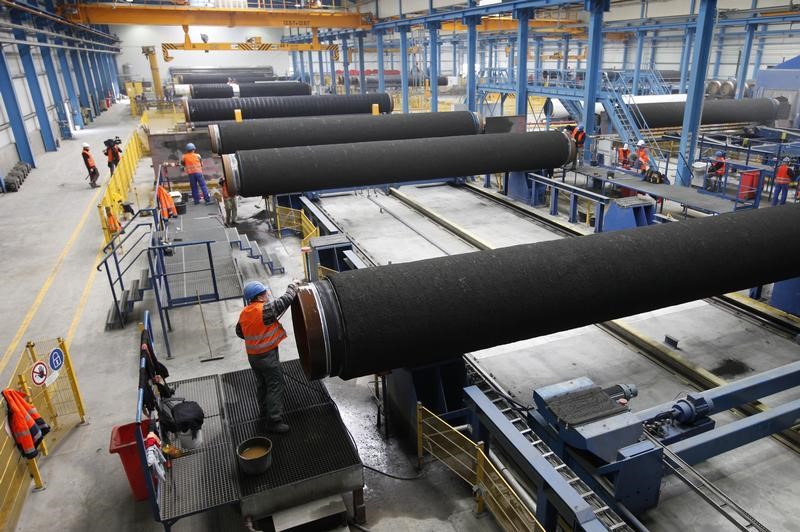(Repeats earlier story with no change to text. The opinions expressed here are those of the author, a columnist for Reuters.)
By Clyde Russell
LAUNCESTON, Australia, Jan 25 (Reuters) - China's record imports of liquefied natural gas (LNG) in December, and the doubling in spot Asian prices in the past six months, appear to contradict the prevailing market view that supply is overwhelming demand for the super-chilled fuel.
But while demand for LNG has definitely firmed in recent months, and not just from China, it's still likely the case that the wave of new projects will push the market into surplus - just perhaps not by as much as some observers had feared.
Similar to other commodities, spot LNG prices in Asia LNG-AS surprised on the upside in the second half of 2016 and early this year, peaking at $9.75 per million British thermal units (mmBtu) in the week ended Jan. 6.
This is more than double the 2016 trough of $4 per mmBtu from Apr. 15, although the gains should be seen in context of the all-time high of $20.50, hit in February 2014.
LNG's slide from the record high three years ago seemed inevitable given the seeming over-investment in the sector. New projects are expected to add 50 percent more capacity between 2016 and 2020, taking global output to about 370 million tonnes.
This figure should be seen in the context of global shipments in the region of 278.5 million tonnes, according to vessel-tracking and port data compiled by Thomson Reuters Supply Chain and Commodity Forecasts.
This represented a 7.8 percent increase, or 20.2 million tonnes, on the 258.3 million tonnes shipped in 2015, the data showed.
Demand was largely led by China, where customs data show that imports rose 32.6 percent in 2016 from the year earlier to 26.06 million tonnes, a gain of 6.4 million tonnes in volume terms.
Strong growth of almost 3 million tonnes was also reported from India, with other countries boosting volumes including Pakistan, Egypt and Jordan.
Top importer Japan was largely steady, with imports down 1.5 percent in the first 11 months of 2016 from the same period a year earlier. Number two buyer South Korea saw a small increase for the year, to 33.417 million tonnes, from 2015's 33.365 million.
Overall, demand growth was a positive story for LNG, and it was sufficient to absorb all the new supply brought on during 2016.
However, the issue for LNG in 2017 and beyond is whether demand can continue to grow strongly enough to meet the supply still to come.
LNG WAVE STILL COMING
The wave of new LNG plants started to come on line in 2015 and 2016, but the big surge is largely still ahead.
In 2016 Australia, which is in the final stages of building eight new plants, added the 15.6 million tonnes per annum Gorgon project, which followed three coal-seam gas to LNG facilities in the country's east coast that added total capacity of 24.8 million tonnes.
Of course, these new facilities were producing at below capacity, as new LNG trains take several months to ramp up and some experienced problems, such as a month-long outage at one of the Gorgon units in December.
But in 2017, it's likely that Australia will add the Wheatstone, Ichthys and Prelude projects, which have a combined capacity of 20.9 million tonnes.
Again, these will take time to ramp up, but all things being equal they should be fully operational by the beginning of 2018, making Australia the world's largest producer of LNG as it overtakes Qatar.
The other major source of new LNG is the United States, where the first two trains at Sabine Pass are already in production, with two more slated for this year.
Five more projects are currently under construction, with start dates slated between 2018 and 2020, bringing the total new capacity expected from the United States to around 66 million tonnes per annum.
It's virtually assured that this capacity is coming given that it is already being built, although the actual production may end up being less than nameplate capacities.
Nonetheless, it's clear that the challenge for the LNG industry will be in finding buyers for the new output.
As developments in China, India and Pakistan in 2016 showed, it's possible for demand to surprise on the upside, but the trick is converting what may be just a short-term surge into sustained long-term demand.
The best way of doing so is to ensure that LNG remains price competitive as well as politically attractive.
In practical terms it will be hard for LNG to become cheaper than coal when it comes to generating electricity in Asia, but it does have the advantage of being cleaner-burning, and more in line with goals to limit climate-affecting pollution.
While spot prices are likely to fall as the northern winter passes, the longer-term outlook is tied to whether enough countries in Asia are prepared to invest in a fuel that isn't the cheapest, but offers environmental advantages.
<^^^^^^^^^^^^^^^^^^^^^^^^^^^^^^^^^^^^^^^^^^^^^^^^^^^^^^^^^^^ GRAPHIC: Australian LNG projects
http://tmsnrt.rs/1VyM4bv
^^^^^^^^^^^^^^^^^^^^^^^^^^^^^^^^^^^^^^^^^^^^^^^^^^^^^^^^^^^> (Editing by Kenneth Maxwell)
